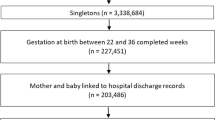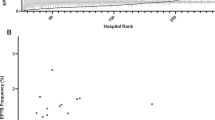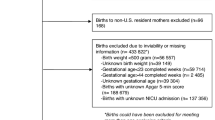Abstract
Objective
To examine trends in rates of preterm birth by race and plurality; to evaluate the association between race, plurality, and phenotypes of preterm birth.
Study design
Temporal trends analyses for preterm birth by race and plurality were performed for the years 1971–2018. Adjusted logistic regression models were utilized to evaluate the association between race, plurality, and phenotypes of preterm birth.
Results
We observed that 1105,266 (0.7%), 1901,604 (1.2%), and 14,769,746 (9.3%) births belonged to extreme preterm, very preterm, and moderate-to-late preterm categories, respectively. We also observed that the risk of extreme preterm (RR: 2.69, 95% CI: 2.642–2.75) was highest for Black mothers as compared to White mothers.
Conclusion
Over the study period, preterm births disproportionately impacted Black mothers as well as pregnancies of higher plurality. With the persistence of racial disparities and growing trend of delayed childbearing and multiple pregnancies, targeted intervention is necessitated toward these vulnerable subgroups.
This is a preview of subscription content, access via your institution
Access options
Subscribe to this journal
Receive 12 print issues and online access
$259.00 per year
only $21.58 per issue
Buy this article
- Purchase on Springer Link
- Instant access to full article PDF
Prices may be subject to local taxes which are calculated during checkout

Similar content being viewed by others
Code availability
The codes will be made available upon request.
References
Harrison MS, Goldenberg RL. Global burden of prematurity. Semin Fetal Neonatal Med. 2016;21:74–9. https://doi.org/10.1016/j.siny.2015.12.007.
Purisch SE, Gyamfi-Bannerman C. Epidemiology of preterm birth. Semin Perinatol. 2017;41:387–91. https://doi.org/10.1053/j.semperi.2017.07.009.
WHO. Preterm birth: key facts. World Health Organization. 2018.
Centers for Disease Control and Prevention. Preterm birth | Maternal and infant health | Reproductive health | CDC. Centers for Disease Control and Prevention. 2018. https://www.cdc.gov/reproductivehealth/maternalinfanthealth/pretermbirth.htm.
Martin JA, Osterman MJK. Describing the Increase in preterm births in the United States, 2014–2016. NCHS Data Brief. 2018;312:1–8.
Frey HA, Klebanoff MA. The epidemiology, etiology, and costs of preterm birth. Semin Fetal Neonatal Med. 2016;21:68–73. https://doi.org/10.1016/j.siny.2015.12.011.
Esplin MS. Overview of spontaneous preterm birth: a complex and multifactorial phenotype. Clin Obstet Gynecol. 2014;57:518–30. https://doi.org/10.1097/GRF.0000000000000037.
Johnson JL, Farr SL, Dietz PM, Sharma AJ, Barfield WD, Robbins CL. Trends in gestational weight gain: the pregnancy risk assessment monitoring system, 2000–2009. Am J Obstet Gynecol. 2015;212:806.e1–806.e8. https://doi.org/10.1016/j.ajog.2015.01.030.
Burris HH, Lorch SA, Kirpalani H, Pursley DWM, Elovitz MA, Clougherty JE. Racial disparities in preterm birth in USA: a biosensor of physical and social environmental exposures. Arch Dis Child. 2019;104:931–5. https://doi.org/10.1136/archdischild-2018-316486.
Mathews TJ, Hamilton BE. Mean age of mothers is on the rise: United States, 2000–2014. NCHS Data Brief. 2016;1–8.
Luke B. Pregnancy and birth outcomes in couples with infertility with and without assisted reproductive technology: with an emphasis on US population-based studies. Am J Obstet Gynecol. 2017;217:270–81. https://doi.org/10.1016/j.ajog.2017.03.012.
Hiersch L, Rosen H, Okby R, Freeman H, Barrett J, Melamed N. The greater risk of preterm birth in triplets is mirrored by a more rapid cervical shortening along gestation. Am J Obstet Gynecol. 2016;215:357.e1–357.e6. https://doi.org/10.1016/j.ajog.2016.03.017.
Gyamfi-Bannerman C, Ananth CV. Trends in spontaneous and indicated preterm delivery among singleton gestations in the United States, 2005–2012. Obstet Gynecol. 2014;124:1069–74. https://doi.org/10.1097/AOG.0000000000000546.
Roth J. NCHS’ vital statistics natality birth data. The National Bureau of Economic Research. 2018. Accessed 19 Jun 2020. http://www.nber.org/data/vital-statistics-natality-data.html.
Dongarwar D, Aggarwal A, Barning K, Salihu HM. Trends in Stillbirths and Stillbirth phenotypes in the United States: an analysis of 131.5 million births. Int J Matern Child Heal Aids. 2020;9:146–8. https://doi.org/10.21106/ijma.344.
Joinpoint Regression Program. Surveillance.cancer.gov. https://surveillance.cancer.gov/joinpoint/. 2020. Accessed 9 Oct 2020.
Klitzman R. Deciding how many embryos to transfer: ongoing challenges and dilemmas. Reprod Biomed Soc Online. 2016;3:1–15. https://doi.org/10.1016/j.rbms.2016.07.001.
Kissin DM, Kulkarni AD, Kushnir VA, Jamieson DJ, National ART Surveillance System Group. Number of embryos transferred after in vitro fertilization and good perinatal outcome. Obstet Gynecol. 2014;123:239–47. https://doi.org/10.1097/AOG.0000000000000106.
Schummers L, Hacker MR, Williams PL, Hutcheon JA, Vanderweele TJ, McElrath T, et al. Variation in relationships between maternal age at first birth and pregnancy outcomes by maternal race: a population-based cohort study in the United States. BMJ Open. 2019. https://doi.org/10.1136/bmjopen-2019-033697.
Balassone MLou. Multiple pregnancies among adolescents: incidence and correlates. Health Soc Work. 1988;13:266–76. https://doi.org/10.1093/hsw/13.4.266.
Centers for Disease Control and Prevention. About teen pregnancy | Teen pregnancy | Reproductive health | CDC. Centers for Disease Control and Prevention. 2016.
Leland NL, Petersen DJ, Braddock M, Alexander GR. Variations in pregnancy outcomes by race among 10–14-year-old mothers in the United States. Public Health Rep. 1995;110:53–8.
Salihu HM, Luke S, Alio AP, Deutsch A, Marty PJ. The impact of obesity on spontaneous and medically indicated preterm birth among adolescent mothers. Arch Gynecol Obstet. 2010;282:127–34. https://doi.org/10.1007/s00404-009-1213-y.
Metcalfe A, Wick J, Ronksley P. Racial disparities in comorbidity and severe maternal morbidity/mortality in the United States: an analysis of temporal trends. Acta Obstet Gynecol Scand. 2018. https://doi.org/10.1111/aogs.13245.
Howell EA, Egorova NN, Balb.ierz A, Zeitlin J, Hebert PL. Site of delivery contribution to black-white severe maternal morbidity disparity. Am J Obstet Gynecol. 2016;215:143–52. https://doi.org/10.1016/j.ajog.2016.05.007.
Headen I, Mujahid MS, Cohen AK, Rehkopf DH, Abrams B. Racial/ethnic disparities in inadequate gestational weight gain differ by pre-pregnancy weight. Matern Child Health J. 2015;19:1672–86. https://doi.org/10.1007/s10995-015-1682-5.
Koullali B, Van Zijl MD, Kazemier BM, et al. The association between parity and spontaneous preterm birth: a population based study. BMC Pregnancy Childbirth. 2020;20:233. https://doi.org/10.1186/s12884-020-02940-w.
Acknowledgements
The corresponding author had full access to all the data and had final responsibility for the decision to submit for publication.
Author information
Authors and Affiliations
Contributions
DD and HMS designed, planned, and conducted the study. DD and LW analyzed the data. All authors contributed to manuscript writing, revision, and approval of the final manuscript.
Corresponding author
Ethics declarations
Conflict of interest
The authors declare that they have no conflict of interest.
Additional information
Publisher’s note Springer Nature remains neutral with regard to jurisdictional claims in published maps and institutional affiliations.
Rights and permissions
Springer Nature or its licensor holds exclusive rights to this article under a publishing agreement with the author(s) or other rightsholder(s); author self-archiving of the accepted manuscript version of this article is solely governed by the terms of such publishing agreement and applicable law.
About this article
Cite this article
Dongarwar, D., Tahseen, D., Wang, L. et al. Temporal trends in preterm birth phenotypes by plurality: Black–White disparity over half a century. J Perinatol 41, 204–211 (2021). https://doi.org/10.1038/s41372-020-00912-8
Received:
Revised:
Accepted:
Published:
Issue Date:
DOI: https://doi.org/10.1038/s41372-020-00912-8
This article is cited by
-
Critical disparities in perinatal health—understanding risks and changing the outcomes
Journal of Perinatology (2021)
-
Commentary on “Trends and Racial Disparities for Acute Kidney Injury in Premature Infants: the US National Database”
Pediatric Nephrology (2021)



